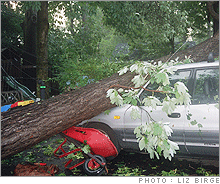|
What I learned when my tree fell down The most painful lesson? I wasn't covered. Spot the gaps in your insurance policy - and fill them.
(MONEY Magazine) -- I consider myself financially savvy, so when my husband told me that our beautiful, 200-year-old red oak had fallen during a rainstorm while I was away, I was sad but not worried. The tree had narrowly missed the house (a blessing!) and landed smack in the middle of our yard. While it was clearly a mess, I felt certain that our homeowners policy would pick up the cost of setting everything right.
Boy, was I wrong. The adjuster, surveying the scene, broke it to us. "I hate to be the bearer of bad news," he said. Not only would our insurer not pay the staggering $10,000 bill for lugging away the tree, but it wasn't likely that we'd get enough money to replace the trees and shrubs that had been wiped out. Had the oak fallen on our house, our homeowners policy would have paid for more of the cleanup and replanting. But because our loss wasn't structural, my husband and I were looking at $20,000 in out-of-pocket costs. Now I know what most homeowners find out only after a disaster: My policy was no blanket. It was more like Swiss cheese. "The insurance policy says it covers you, then the fine print takes it all back," says James Stipp, an independent insurance agent in Manhasset, N.Y. Unfortunately, you can't insure against everything - your policy may not cover damage if the cause was your failure to make repairs, for instance - but you should plug whatever holes you can. Rebuilding Shortfall Take a peek at your policy limit on the declarations page. Is that enough to rebuild your house? Nearly two-thirds of homes are insured for less than their full value, with the average shortfall 22%, according to Marshall & Swift/Boeckh, a firm that tracks building costs. Add in escalating construction and materials costs (up 7.8% since May 2005), and you can see why it's easy to be underinsured. To get the best estimate of how much coverage you need, ask a contractor what it would cost to rebuild your prize. To be safe, make sure your policy has an inflation guard, so that its value will be adjusted to account for rising prices. Your initial premium won't be any higher if you get this feature, but it may go up with inflation. Valuables Void The standard homeowners policy is one size, but it doesn't fit all. It won't cover your collection of rare baseball cards, say, or African art. For that you need to buy a rider, also called a floater or an endorsement. You'll typically pay 1% to 4% of the item's value, says Jeanne Salvatore of the Insurance Information Institute. If you stash your goodies in a safe-deposit box, you still need insurance, though it will cost less. The Water Gap Nearly a year after Hurricane Katrina, you no doubt know that if you live in a flood zone you need flood insurance (check at fema.gov). These policies are backed by the federal government but sold by your agent. Also, check to see if your homeowners policy has a hurricane deductible. If it does, you will have to cover thousands in repairs before insurance kicks in. Another water hazard: Sewers and drain backups aren't necessarily covered, so you need a rider. And if you live in an area where cataclysmic weather is common, make sure your policy will pay for you to meet building-code requirements that weren't in place when your house was built. |
|


